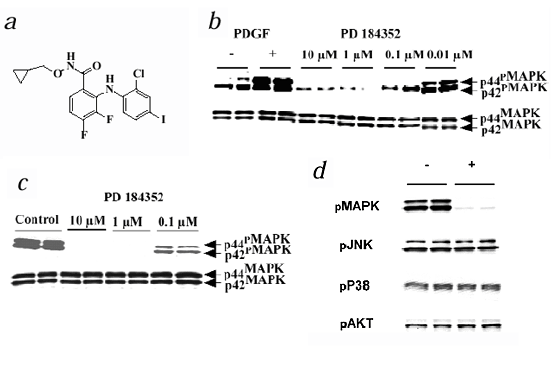
- Select a language for the TTS:
- UK English Female
- UK English Male
- US English Female
- US English Male
- Australian Female
- Australian Male
- Language selected: (auto detect) - EN
Play all audios:
ABSTRACT The mitogen-activated protein kinase pathway is thought to be essential in cellular growth and differentiation. Here we report the discovery of a highly potent and selective
inhibitor of the upstream kinase MEK that is orally active. Tumor growth was inhibited as much as 80% in mice with colon carcinomas of both mouse and human origin after treatment with this
inhibitor. Efficacy was achieved with a wide range of doses with no signs of toxicity, and correlated with a reduction in the levels of activated mitogen-activated protein kinase in excised
tumors. These data indicate that MEK inhibitors represent a promising, noncytotoxic approach to the clinical management of colon cancer. Access through your institution Buy or subscribe This
is a preview of subscription content, access via your institution ACCESS OPTIONS Access through your institution Subscribe to this journal Receive 12 print issues and online access $209.00
per year only $17.42 per issue Learn more Buy this article * Purchase on SpringerLink * Instant access to full article PDF Buy now Prices may be subject to local taxes which are calculated
during checkout ADDITIONAL ACCESS OPTIONS: * Log in * Learn about institutional subscriptions * Read our FAQs * Contact customer support SIMILAR CONTENT BEING VIEWED BY OTHERS A
FIRST-IN-CLASS SELECTIVE INHIBITOR OF EGFR AND PI3K OFFERS A SINGLE-MOLECULE APPROACH TO TARGETING ADAPTIVE RESISTANCE Article Open access 11 July 2024 SELECTIVE INHIBITORS OF MTORC1
ACTIVATE 4EBP1 AND SUPPRESS TUMOR GROWTH Article 24 June 2021 MOLECULAR TARGETED THERAPY FOR ANTICANCER TREATMENT Article Open access 12 October 2022 REFERENCES * Lewis, T.S., Shapiro, P.S.
& Ahn, N.G. Signal transduction through MAP kinase cascades. _ Adv.Cancer Res._ 74, 49–139 (1998). Article CAS Google Scholar * Cobb, M.H. & Goldsmith, E.J. How MAP kinases are
regulated. _J. Biol. Chem._ 270, 14843– 14846 (1995). Article CAS Google Scholar * Warne, P.H., Viciana, P.R. & Downward, J. Direct interaction of Ras and the amino-terminal region of
Raf-1 _in vitro_. _Nature_ 364, 352–355 (1993). Article CAS Google Scholar * Dent, P. et al. Activation of mitogen-activated protein kinase kinase by v-Raf in NIH 3T3 cells and _in
vitro_. _Science_ 257, 1404–1407 (1992). Article CAS Google Scholar * Crews, C.M., Alessandrini, A. & Erikson, R.L. The primary structure of MEK, a protein kinase that phosphorylates
the ERK gene product. _Science_ 258, 478–480 (1992). Article CAS Google Scholar * Her, J.H. _et al._ Dual phosphorylation and autophosphorylation in mitogen-activated protein (MAP) kinase
activation. _Biochem. J._ 296, 25–31 (1993). Article CAS Google Scholar * Anderson, N.G., Maller, J.L., Tonks, N.K. & Sturgill, T.W. Requirement for integration of signals from two
distinct phosphorylation pathways for activation of MAP kinase. _Nature_ 343, 651–653 (1990). Article CAS Google Scholar * Marais, R., Wynne, J. & Treisman, R. The SRF accessory
protein Elk-1 contains a growth factor-regulated transcriptional activation domain. _Cell_ 73, 381–393 (1993). Article CAS Google Scholar * Pang, L., Sawada, T., Decker, S.J. &
Saltiel, A.R. Inhibition of MAP kinase kinase blocks the differentiation of PC-12 cells induced by nerve growth factor. _J. Biol. Chem._ 270, 13585–13588 (1995). Article CAS Google Scholar
* Cowley, S., Paterson, H., Kemp, P. & Marshall, C.J. Activation of MAP kinase kinase is necessary and sufficient for PC12 differentiation and for transformation of NIH3T3 cells.
_Cell_ 77, 841–852 (1994). Article CAS Google Scholar * Seger, R. _et al._ Purification and characterization of mitogen-activated protein kinase activator(s) from epidermal growth
factor-stimulated A431 cells. _ J. Biol. Chem._ 267, 14373–14381 (1992). CAS PubMed Google Scholar * Mansour, S.J. _ et al._ Transformation of mammalian cells by constitutively active MAP
kinase kinase. _Science_ 265, 966– 970 (1994). Article CAS Google Scholar * Dudley, D.T. & Saltiel, A.R. in _Signal Transduction, Cell Cycle, and Their Inhibitors_ (ed. Gutkind,
J.S.)(Humana, Totowa, New Jersey, in the press). * Dudley, D.T., Pang, L., Decker, S.J., Bridges, A.J. & Saltiel, A.R. A synthetic inhibitor of the mitogen-activated protein kinase
cascade. _Proc. Natl. Acad. Sci. USA_ 92, 7686–7689 (1995). Article CAS Google Scholar * Alessi, D.R., Cuenda, A., Cohen, P., Dudley, D.T. & Saltiel, A.R. PD 098059 is a specific
inhibitor of the activation of mitogen-activated protein kinase kinase _in vitro_ and _in vivo_. _J. Biol. Chem._ 270, 27489– 27494 (1995). Article CAS Google Scholar * Pages, G. _et al._
Mitogen-activated protein kinases p42mapk and p44mapk are required for fibroblast proliferation. _Proc. Natl. Acad. Sci USA_ 90, 8319–8323 (1993). Article CAS Google Scholar * Streit,
M., Schmidt, R., Hilgenfeld, R.U., Thiel, E. & Kreuser, E.D. Adhesion receptors in malignant transformation and dissemination of gastrointestinal tumors. _J. Mol. Med._ 74, 253–268 (
1996). Article CAS Google Scholar * Ridley, A.J., Comoglio, P.M. & Hall, A. Regulation of scatter factor/hepatocyte growth factor responses by Ras, Rac and Rho in MDCK cells. _Mol.
Cell Biol._ 15, 1110–1122 (1995). Article CAS Google Scholar * Herrera, R. Modulation of hepatocyte growth factor-induced scattering of HT29 colon carcinoma cells. Involvement of the MAPK
pathway. _J. Cell Science_ 111, 1039–1049 (1998). CAS PubMed Google Scholar * Potempa, S. & Ridley, A.J. Activation of both MAP kinase and phosphatidylinositide 3-kinase by Ras is
required for hepatocyte growth factor/scatter factor-induced adherens junction disassembly. _Mol. Biol. Cell_ 9, 2185–2200 (1998). Article CAS Google Scholar * Tanimura, S. _ et al._
Activation of the 41/43 kDa mitogen-activated protein kinase signaling pathway is required for hepatocyte growth factor-induced cell scattering. _Oncogene_ 17, 57–65 (1998). Article CAS
Google Scholar * Webb, C.P., Van Aelst, L., Wigler, M.H. & Vande Woude, G.F. Signaling pathways in Ras-mediated tumorigenicity and metastasis. _ Proc. Natl. Acad. Sci. USA_ 95, 8773–
8778 (1998). Article CAS Google Scholar * Khwaja, A., Lehmann, K., Marte, B.M. & Downward, J. Phosphoinositide 3-kinase induces scattering and tubulogenesis in epithelial cells
through a novel pathway. _J. Biol. Chem._ 273, 18793–18801 (1998). Article CAS Google Scholar * Takahashi-Tezuka, M. _ et al._ Gab1 acts as an adapter molecule linking the cytokine
receptor gp130 to ERK mitogen-activated protein kinase. _Mol. Cell. Biol._ 18, 4109–4117 (1998). Article CAS Google Scholar * Weidner, K.M. _ et al._ Interaction between Gab1 and the
c-Met receptor tyrosine kinase is responsible for epithelial morphogenesis. _Nature_ 384, 173–176 (1996). Article CAS Google Scholar * Klemke, R.L. _ et al._ Regulation of cell motility
by mitogen-activated protein kinase. _J. Cell Biol._ 137, 481– 492 (1997). Article CAS Google Scholar * Corbett, T.H., Griswold, D.P., Roberts, B.J., Peckham, J.C. & Schabel, F.M.
Tumor induction relationships in development of transplantable cancers of the colon in mice for chemotherapy assays with a note on carcinogen structure. _Cancer Res._ 35, 2434–2439 (1975).
CAS PubMed Google Scholar * Sivaraman, V.S., Wang, H., Nuovo, G.J. & Malbon, C.C. Hyperexpression of mitogen-activated protein kinase in human breast cancer. _J. Clin. Invest._ 99,
1478–1483 (1997). Article CAS Google Scholar * Mandell, J.W., Hussaini, I.M., Zecevic, M., Weber, M.J. & VandenBerg, S.R. _In situ_ visualization of intratumor growth factor
signaling. Immunohistochemical localization of activated ERK/MAP kinase in glial neoplasms. _Amer. J. Pathol._ 153, 1411–1423 (1998). Article CAS Google Scholar * Hoshino, R. _ et al._
Constitutive activation of the 41-/43-kDa mitogen-activated protein kinase signaling pathway in human tumors. _Oncogene_ 18, 813–822 (1999). Article CAS Google Scholar * Licato, L.L. _ et
al._ _In vivo_ activation of mitogen-activated protein kinases in rat intestinal neoplasia. _Gastroenterology_ 113, 1589–1598 (1997). Article CAS Google Scholar * Licato, L.L. &
Brenner. D.A. Analysis of signaling protein kinases in human colon or colorectal carcinomas. _Dig. Dis. Sci._ 43, 1454–1464 (1998). Article CAS Google Scholar * Eliceiri, B.P., Klemke R.,
Stromblad, S. & Cheresh, D.A. Integrin alphavbeta3 requirement for sustained mitogen-activated protein kinase activity during angiogenesis. _J. Cell Biol._ 140, 1255– 1263 (1998).
Article CAS Google Scholar * Milanini, J., Vinals, F., Pouyssegur, J. & Pages, G. p42/p44 MAP kinase module plays a key role in the transcriptional regulation of the vascular
endothelial growth factor gene in fibroblasts. _ J. Biol. Chem._ 273, 18165–18172 (1998). Article CAS Google Scholar * Petit, A.M. _ et al._ Neutralizing antibodies against epidermal
growth factor and ErbB-2/neu receptor tyrosine kinases down-regulate vascular endothelial growth factor production by tumor cells _in vitro_ and _in vivo_: angiogenic implications for signal
transduction therapy of solid tumors. _ Am. J. Pathol._ 151, 1523–1530 (1997). CAS PubMed PubMed Central Google Scholar * Fiddes, R.J. _ et al._ Inhibition of the MAP kinase cascade
blocks heregulin-induced cell cycle progression in T-47D human breast cancer cells. _Oncogene_ 16, 2803–2813 (1998). Article CAS Google Scholar * Amundadottir, L.T. & Leder, P. Signal
transduction pathways activated and required for mammary carcinogenesis in response to specific oncogenes. _Oncogene_ 16, 737– 746 (1998). Article CAS Google Scholar Download references
ACKNOWLEDGEMENTS We thank J. Fergus for technical assistance. AUTHOR INFORMATION AUTHORS AND AFFILIATIONS * Department of Cell Biology, Division of Warner-Lambert, Parke-Davis Pharmaceutical
Research, 2800 Plymouth Road, Ann Arbor, 48105, Michigan, USA Judith S. Sebolt-Leopold, David T. Dudley, Roman Herrera, Keri Van Becelaere, Amy Wiland, Richard C. Gowan & Alan R.
Saltiel * Department of Chemistry, Division of Warner-Lambert, Parke-Davis Pharmaceutical Research, 2800 Plymouth Road, Ann Arbor, 48105, Michigan, USA Haile Tecle, Stephen D. Barrett &
Alexander Bridges * Department of Cancer Research, Division of Warner-Lambert, Parke-Davis Pharmaceutical Research, 2800 Plymouth Road, Ann Arbor, 48105, Michigan, USA Sally Przybranowski
& W.R. Leopold Authors * Judith S. Sebolt-Leopold View author publications You can also search for this author inPubMed Google Scholar * David T. Dudley View author publications You can
also search for this author inPubMed Google Scholar * Roman Herrera View author publications You can also search for this author inPubMed Google Scholar * Keri Van Becelaere View author
publications You can also search for this author inPubMed Google Scholar * Amy Wiland View author publications You can also search for this author inPubMed Google Scholar * Richard C. Gowan
View author publications You can also search for this author inPubMed Google Scholar * Haile Tecle View author publications You can also search for this author inPubMed Google Scholar *
Stephen D. Barrett View author publications You can also search for this author inPubMed Google Scholar * Alexander Bridges View author publications You can also search for this author
inPubMed Google Scholar * Sally Przybranowski View author publications You can also search for this author inPubMed Google Scholar * W.R. Leopold View author publications You can also search
for this author inPubMed Google Scholar * Alan R. Saltiel View author publications You can also search for this author inPubMed Google Scholar RIGHTS AND PERMISSIONS Reprints and
permissions ABOUT THIS ARTICLE CITE THIS ARTICLE Sebolt-Leopold, J., Dudley, D., Herrera, R. _et al._ Blockade of the MAP kinase pathway suppresses growth of colon tumors _ in vivo_. _Nat
Med_ 5, 810–816 (1999). https://doi.org/10.1038/10533 Download citation * Received: 31 March 1999 * Accepted: 30 April 1999 * Issue Date: July 1999 * DOI: https://doi.org/10.1038/10533 SHARE
THIS ARTICLE Anyone you share the following link with will be able to read this content: Get shareable link Sorry, a shareable link is not currently available for this article. Copy to
clipboard Provided by the Springer Nature SharedIt content-sharing initiative





:max_bytes(150000):strip_icc():focal(749x0:751x2)/naomi-campbell-436a07a4814f45d881c4db13c4e433c0.jpg)

